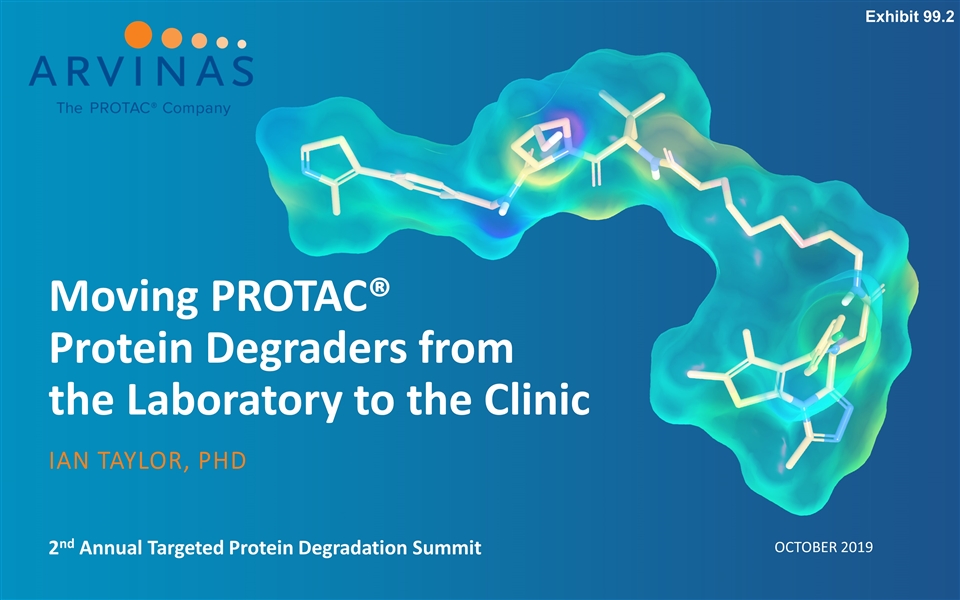
Moving PROTAC® Protein Degraders from the Laboratory to the Clinic IAN TAYLOR, PHD 2nd Annual Targeted Protein Degradation Summit OCTOBER 2019 Exhibit 99.2
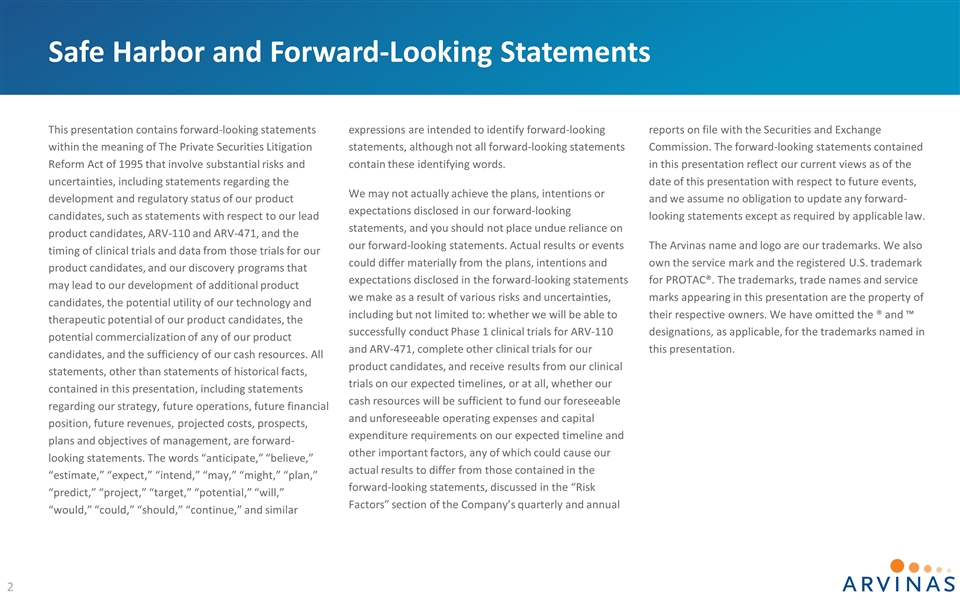
Safe Harbor and Forward-Looking Statements This presentation contains forward-looking statements within the meaning of The Private Securities Litigation Reform Act of 1995 that involve substantial risks and uncertainties, including statements regarding the development and regulatory status of our product candidates, such as statements with respect to our lead product candidates, ARV-110 and ARV-471, and the timing of clinical trials and data from those trials for our product candidates, and our discovery programs that may lead to our development of additional product candidates, the potential utility of our technology and therapeutic potential of our product candidates, the potential commercialization of any of our product candidates, and the sufficiency of our cash resources. All statements, other than statements of historical facts, contained in this presentation, including statements regarding our strategy, future operations, future financial position, future revenues, projected costs, prospects, plans and objectives of management, are forward-looking statements. The words “anticipate,” “believe,” “estimate,” “expect,” “intend,” “may,” “might,” “plan,” “predict,” “project,” “target,” “potential,” “will,” “would,” “could,” “should,” “continue,” and similar expressions are intended to identify forward-looking statements, although not all forward-looking statements contain these identifying words. We may not actually achieve the plans, intentions or expectations disclosed in our forward-looking statements, and you should not place undue reliance on our forward-looking statements. Actual results or events could differ materially from the plans, intentions and expectations disclosed in the forward-looking statements we make as a result of various risks and uncertainties, including but not limited to: whether we will be able to successfully conduct Phase 1 clinical trials for ARV-110 and ARV-471, complete other clinical trials for our product candidates, and receive results from our clinical trials on our expected timelines, or at all, whether our cash resources will be sufficient to fund our foreseeable and unforeseeable operating expenses and capital expenditure requirements on our expected timeline and other important factors, any of which could cause our actual results to differ from those contained in the forward-looking statements, discussed in the “Risk Factors” section of the Company’s quarterly and annual reports on file with the Securities and Exchange Commission. The forward-looking statements contained in this presentation reflect our current views as of the date of this presentation with respect to future events, and we assume no obligation to update any forward-looking statements except as required by applicable law. The Arvinas name and logo are our trademarks. We also own the service mark and the registered U.S. trademark for PROTAC®. The trademarks, trade names and service marks appearing in this presentation are the property of their respective owners. We have omitted the ® and ™ designations, as applicable, for the trademarks named in this presentation.
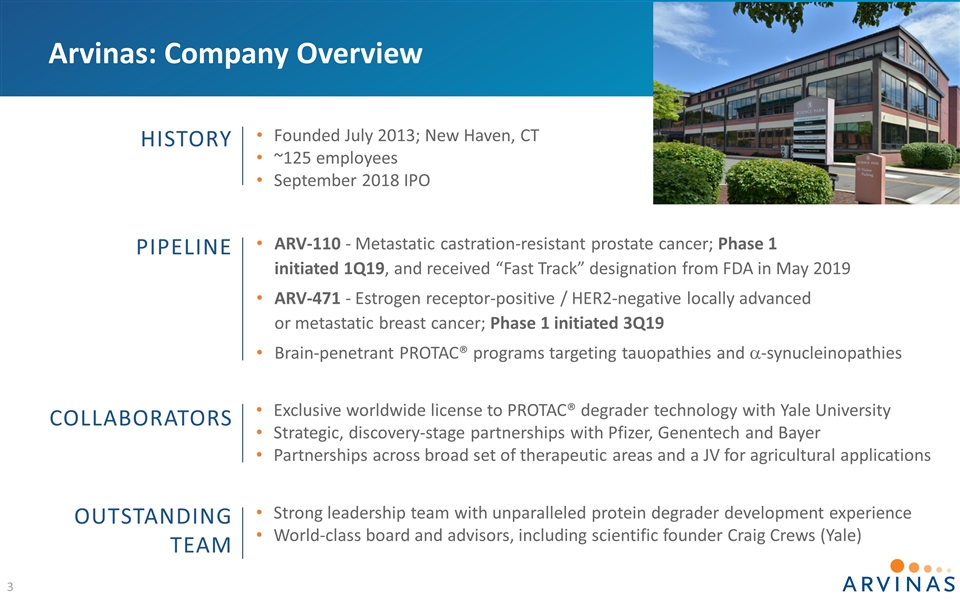
Arvinas: Company Overview PIPELINE ARV-110 - Metastatic castration-resistant prostate cancer; Phase 1 initiated 1Q19, and received “Fast Track” designation from FDA in May 2019 ARV-471 - Estrogen receptor-positive / HER2-negative locally advanced or metastatic breast cancer; Phase 1 initiated 3Q19 Brain-penetrant PROTAC® programs targeting tauopathies and a-synucleinopathies OUTSTANDING TEAM Strong leadership team with unparalleled protein degrader development experience World-class board and advisors, including scientific founder Craig Crews (Yale) HISTORY Founded July 2013; New Haven, CT ~125 employees September 2018 IPO COLLABORATORS Exclusive worldwide license to PROTAC® degrader technology with Yale University Strategic, discovery-stage partnerships with Pfizer, Genentech and Bayer Partnerships across broad set of therapeutic areas and a JV for agricultural applications
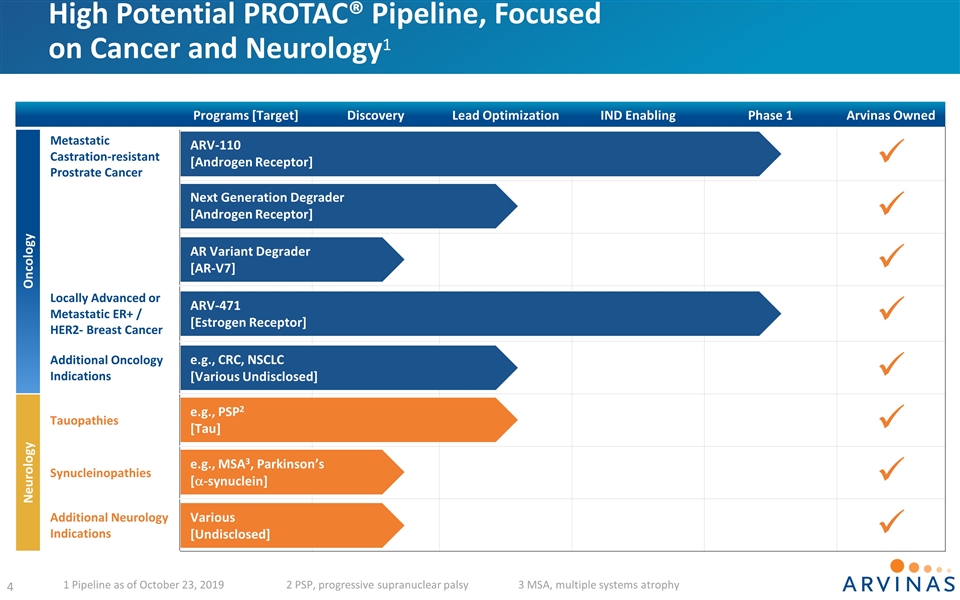
High Potential PROTAC® Pipeline, Focused on Cancer and Neurology1 1 Pipeline as of October 23, 2019 Programs [Target] Discovery Lead Optimization IND Enabling Phase 1 Arvinas Owned Oncology Metastatic Castration-resistant Prostrate Cancer ü ü ü Locally Advanced or Metastatic ER+ / HER2- Breast Cancer ü Additional Oncology Indications ü Neurology Tauopathies ü Synucleinopathies ü Additional Neurology Indications ü ARV-110 [Androgen Receptor] Next Generation Degrader [Androgen Receptor] AR Variant Degrader [AR-V7] ARV-471 [Estrogen Receptor] e.g., CRC, NSCLC [Various Undisclosed] e.g., PSP2 [Tau] e.g., MSA3, Parkinson’s [a-synuclein] Various [Undisclosed] 2 PSP, progressive supranuclear palsy 3 MSA, multiple systems atrophy
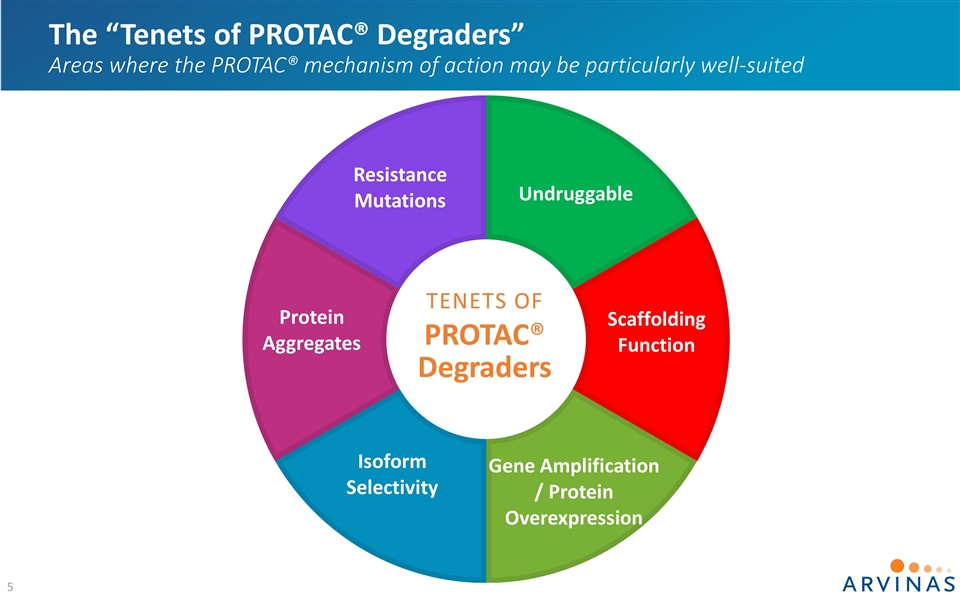
The “Tenets of PROTAC® Degraders” Areas where the PROTAC® mechanism of action may be particularly well-suited TENETS OF PROTAC® Degraders
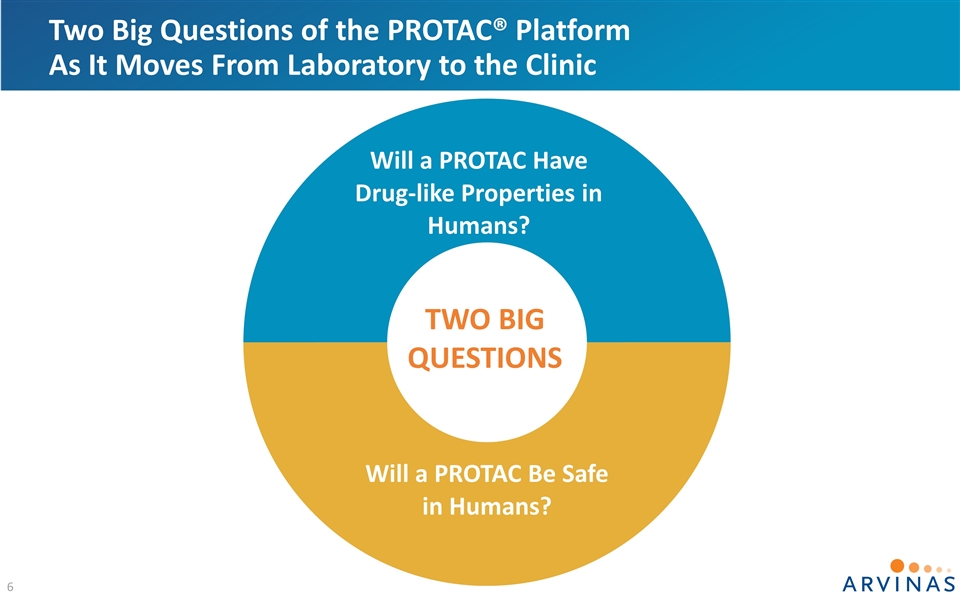
Two Big Questions of the PROTAC® Platform As It Moves From Laboratory to the Clinic TWO BIG QUESTIONS
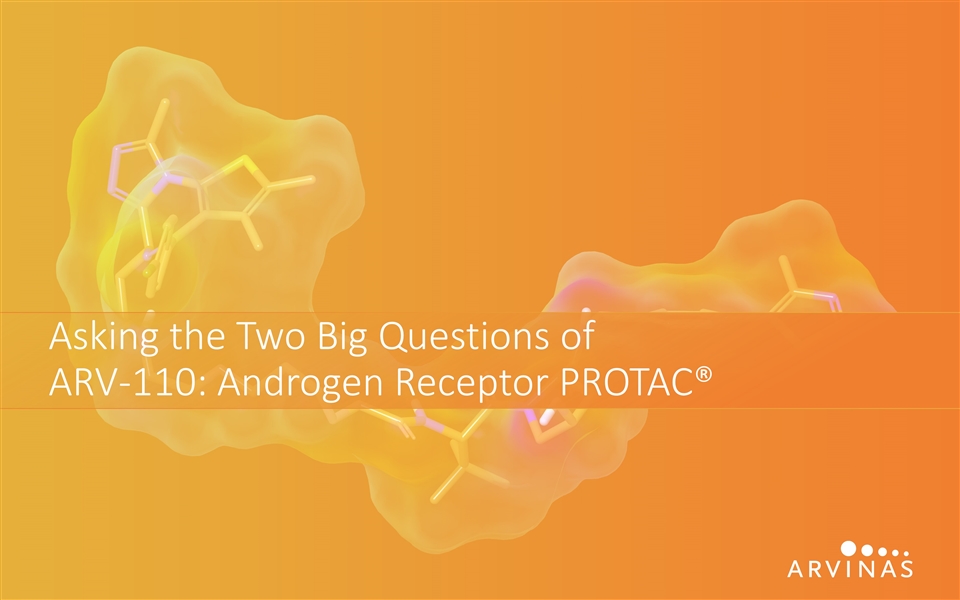
Asking the Two Big Questions of ARV-110: Androgen Receptor PROTAC®
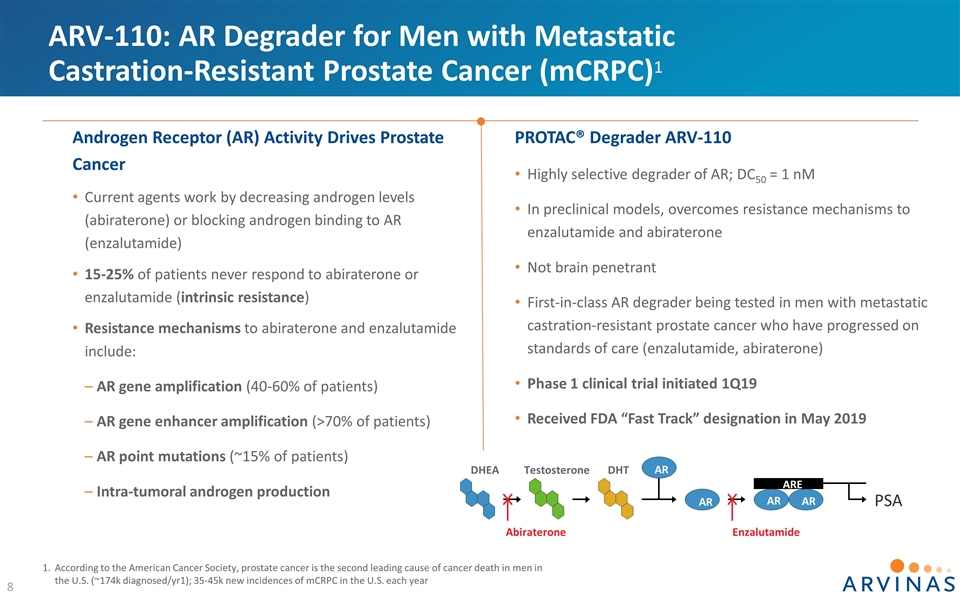
Androgen Receptor (AR) Activity Drives Prostate Cancer Current agents work by decreasing androgen levels (abiraterone) or blocking androgen binding to AR (enzalutamide) 15-25% of patients never respond to abiraterone or enzalutamide (intrinsic resistance) Resistance mechanisms to abiraterone and enzalutamide include: AR gene amplification (40-60% of patients) AR gene enhancer amplification (>70% of patients) AR point mutations (~15% of patients) Intra-tumoral androgen production PROTAC® Degrader ARV-110 Highly selective degrader of AR; DC50 = 1 nM In preclinical models, overcomes resistance mechanisms to enzalutamide and abiraterone Not brain penetrant First-in-class AR degrader being tested in men with metastatic castration-resistant prostate cancer who have progressed on standards of care (enzalutamide, abiraterone) Phase 1 clinical trial initiated 1Q19 Received FDA “Fast Track” designation in May 2019 According to the American Cancer Society, prostate cancer is the second leading cause of cancer death in men in the U.S. (~174k diagnosed/yr1); 35-45k new incidences of mCRPC in the U.S. each year ARV-110: AR Degrader for Men with Metastatic Castration-Resistant Prostate Cancer (mCRPC)1 DHEA Testosterone DHT AR AR AR AR ARE Abiraterone Enzalutamide AR PSA
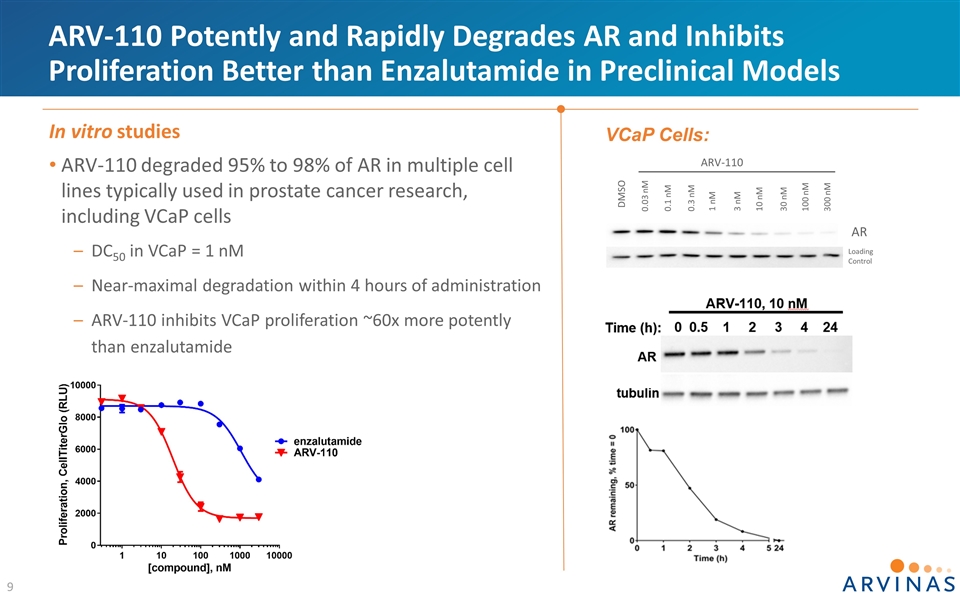
ARV-110 Potently and Rapidly Degrades AR and Inhibits Proliferation Better than Enzalutamide in Preclinical Models In vitro studies ARV-110 degraded 95% to 98% of AR in multiple cell lines typically used in prostate cancer research, including VCaP cells DC50 in VCaP = 1 nM Near-maximal degradation within 4 hours of administration ARV-110 inhibits VCaP proliferation ~60x more potently than enzalutamide VCaP Cells: DMSO 3 nM 10 nM 30 nM 100 nM 300 nM 1 nM 0.3 nM 0.1 nM 0.03 nM ARV-110 AR Loading Control
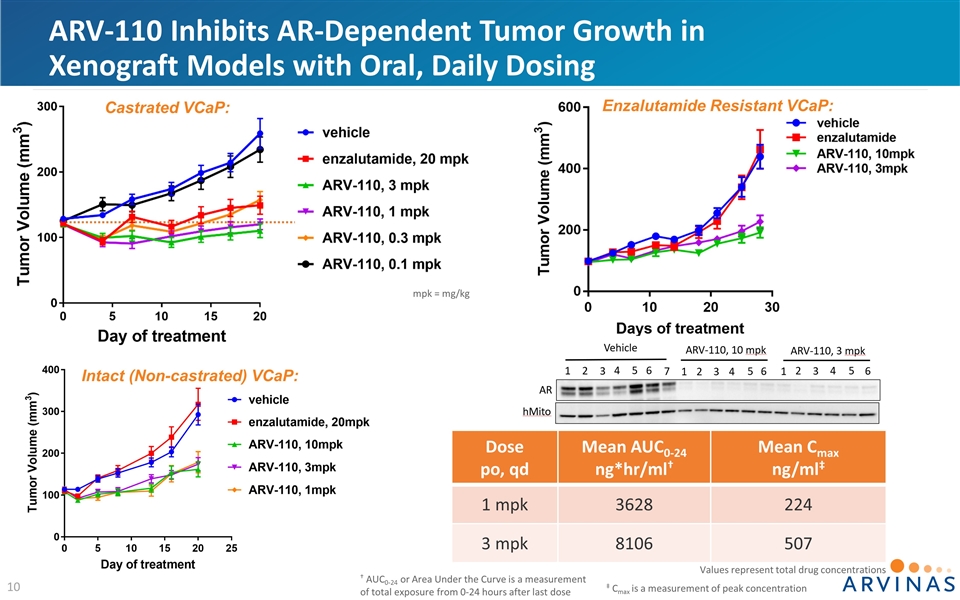
ARV-110 Inhibits AR-Dependent Tumor Growth in Xenograft Models with Oral, Daily Dosing Intact (Non-castrated) VCaP: Dose po, qd Mean AUC0-24 ng*hr/ml† Mean Cmax ng/ml‡ 1 mpk 3628 224 3 mpk 8106 507 Castrated VCaP: mpk = mg/kg Enzalutamide Resistant VCaP: Values represent total drug concentrations † AUC0-24 or Area Under the Curve is a measurement of total exposure from 0-24 hours after last dose ‡ Cmax is a measurement of peak concentration
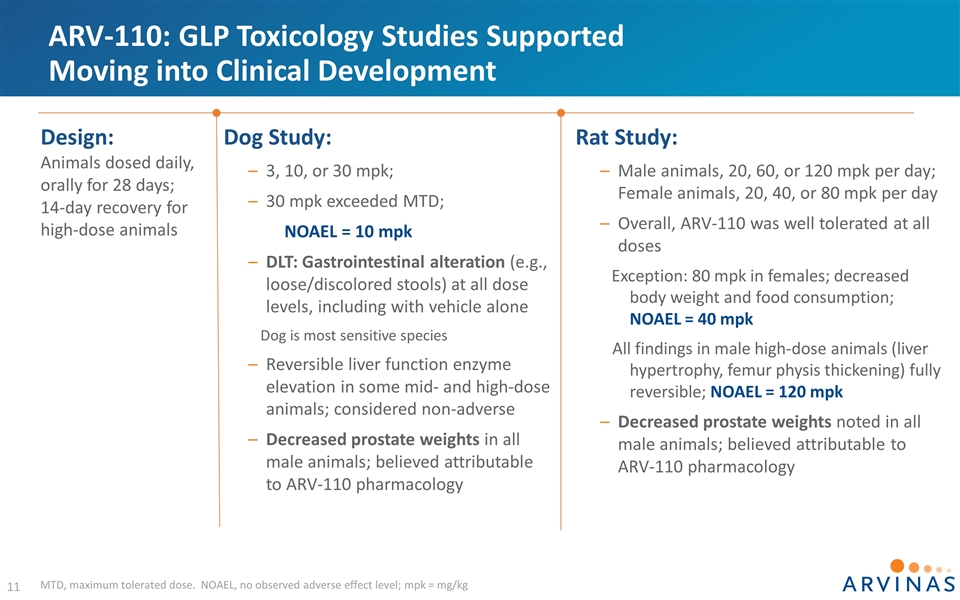
MTD, maximum tolerated dose. NOAEL, no observed adverse effect level; mpk = mg/kg ARV-110: GLP Toxicology Studies Supported Moving into Clinical Development Rat Study: Male animals, 20, 60, or 120 mpk per day; Female animals, 20, 40, or 80 mpk per day Overall, ARV-110 was well tolerated at all doses Exception: 80 mpk in females; decreased body weight and food consumption; NOAEL = 40 mpk All findings in male high-dose animals (liver hypertrophy, femur physis thickening) fully reversible; NOAEL = 120 mpk Decreased prostate weights noted in all male animals; believed attributable to ARV-110 pharmacology Design: Animals dosed daily, orally for 28 days; 14-day recovery for high-dose animals Dog Study: 3, 10, or 30 mpk; 30 mpk exceeded MTD; NOAEL = 10 mpk DLT: Gastrointestinal alteration (e.g., loose/discolored stools) at all dose levels, including with vehicle alone Dog is most sensitive species Reversible liver function enzyme elevation in some mid- and high-dose animals; considered non-adverse Decreased prostate weights in all male animals; believed attributable to ARV-110 pharmacology
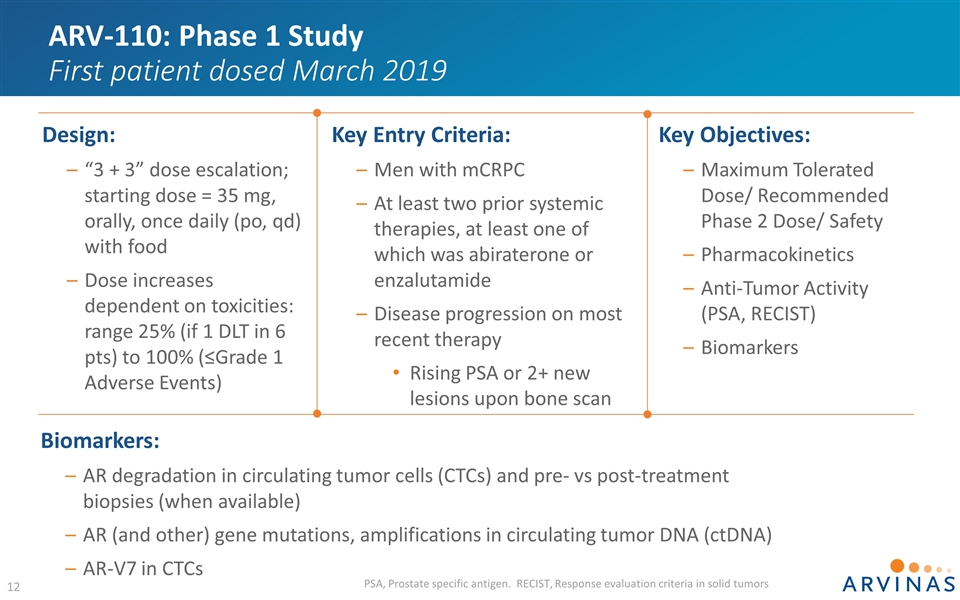
ARV-110: Phase 1 Study First patient dosed March 2019 Key Objectives: Maximum Tolerated Dose/ Recommended Phase 2 Dose/ Safety Pharmacokinetics Anti-Tumor Activity (PSA, RECIST) Biomarkers Biomarkers: AR degradation in circulating tumor cells (CTCs) and pre- vs post-treatment biopsies (when available) AR (and other) gene mutations, amplifications in circulating tumor DNA (ctDNA) AR-V7 in CTCs Design: “3 + 3” dose escalation; starting dose = 35 mg, orally, once daily (po, qd) with food Dose increases dependent on toxicities: range 25% (if 1 DLT in 6 pts) to 100% (≤Grade 1 Adverse Events) Key Entry Criteria: Men with mCRPC At least two prior systemic therapies, at least one of which was abiraterone or enzalutamide Disease progression on most recent therapy Rising PSA or 2+ new lesions upon bone scan PSA, Prostate specific antigen. RECIST, Response evaluation criteria in solid tumors
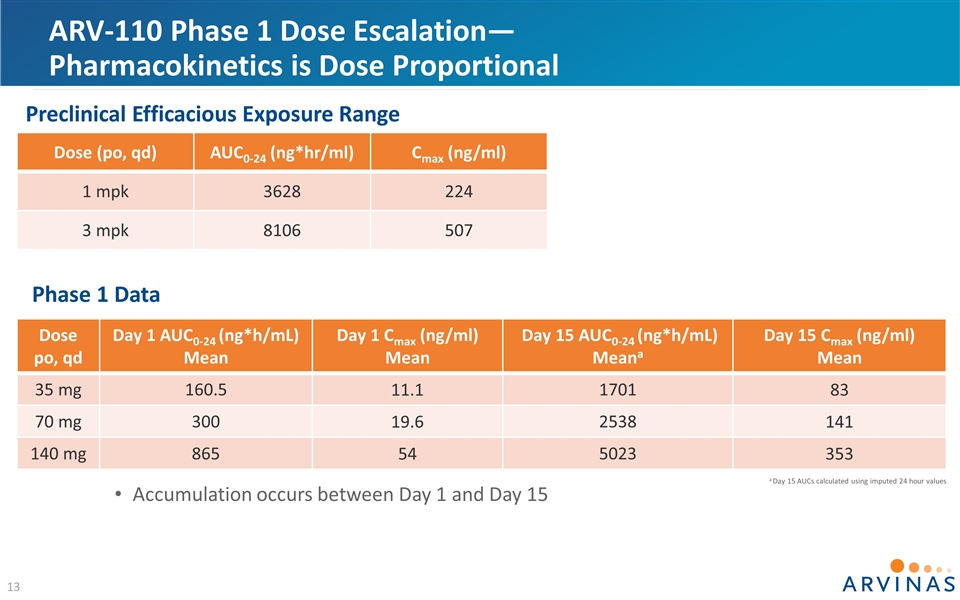
ARV-110 Phase 1 Dose Escalation—Pharmacokinetics is Dose Proportional Dose po, qd Day 1 AUC0-24 (ng*h/mL) Mean Day 1 Cmax (ng/ml) Mean Day 15 AUC0-24 (ng*h/mL) Meana Day 15 Cmax (ng/ml) Mean 35 mg 160.5 11.1 1701 83 70 mg 300 19.6 2538 141 140 mg 865 54 5023 353 Phase 1 Data a Day 15 AUCs calculated using imputed 24 hour values Dose (po, qd) AUC0-24 (ng*hr/ml) Cmax (ng/ml) 1 mpk 3628 224 3 mpk 8106 507 Preclinical Efficacious Exposure Range Accumulation occurs between Day 1 and Day 15
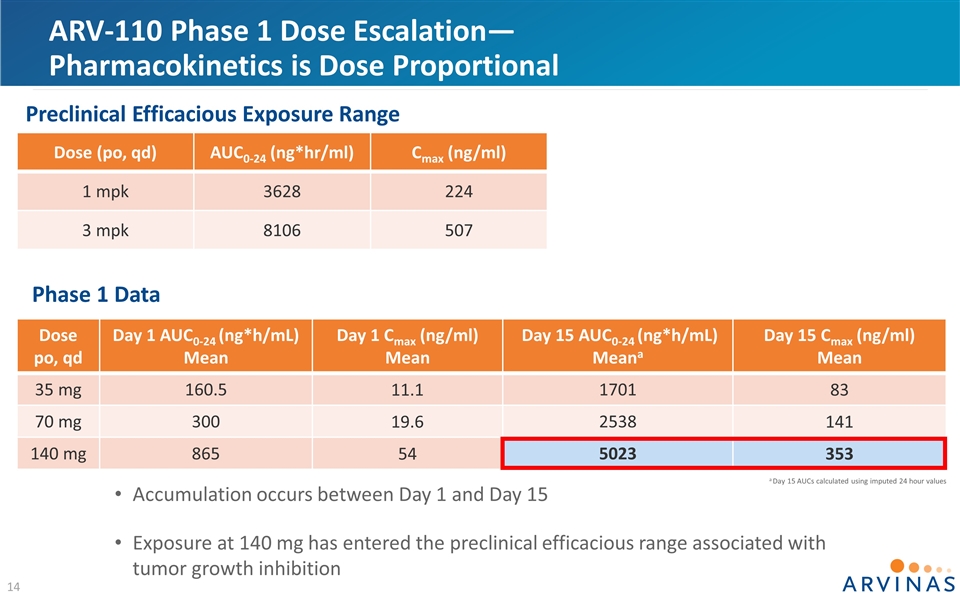
ARV-110 Phase 1 Dose Escalation—Pharmacokinetics is Dose Proportional Dose po, qd Day 1 AUC0-24 (ng*h/mL) Mean Day 1 Cmax (ng/ml) Mean Day 15 AUC0-24 (ng*h/mL) Meana Day 15 Cmax (ng/ml) Mean 35 mg 160.5 11.1 1701 83 70 mg 300 19.6 2538 141 140 mg 865 54 5023 353 Phase 1 Data a Day 15 AUCs calculated using imputed 24 hour values Dose (po, qd) AUC0-24 (ng*hr/ml) Cmax (ng/ml) 1 mpk 3628 224 3 mpk 8106 507 Preclinical Efficacious Exposure Range Accumulation occurs between Day 1 and Day 15 Exposure at 140 mg has entered the preclinical efficacious range associated with tumor growth inhibition
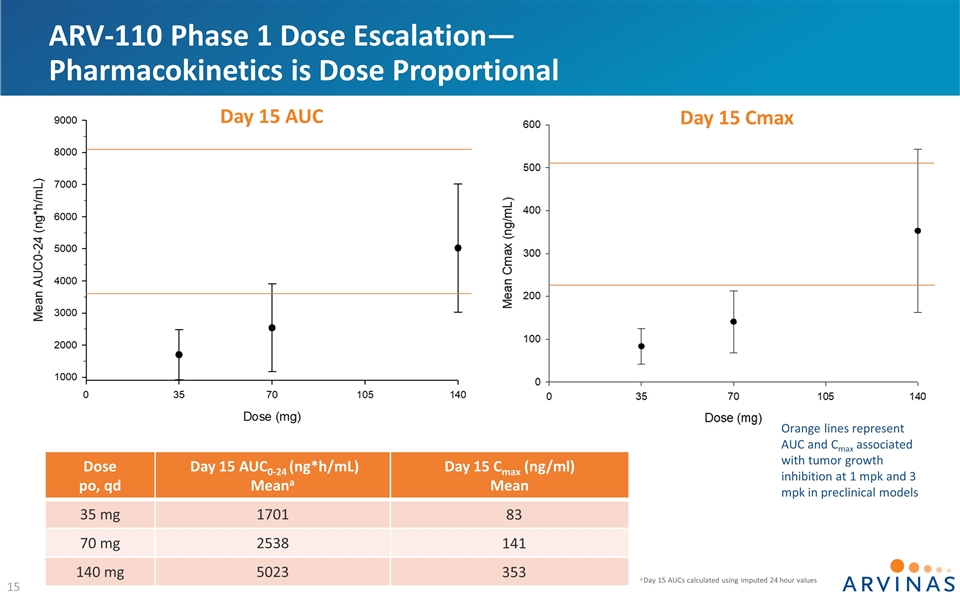
ARV-110 Phase 1 Dose Escalation—Pharmacokinetics is Dose Proportional Day 15 AUC Day 15 Cmax Dose po, qd Day 15 AUC0-24 (ng*h/mL) Meana Day 15 Cmax (ng/ml) Mean 35 mg 1701 83 70 mg 2538 141 140 mg 5023 353 a Day 15 AUCs calculated using imputed 24 hour values Orange lines represent AUC and Cmax associated with tumor growth inhibition at 1 mpk and 3 mpk in preclinical models
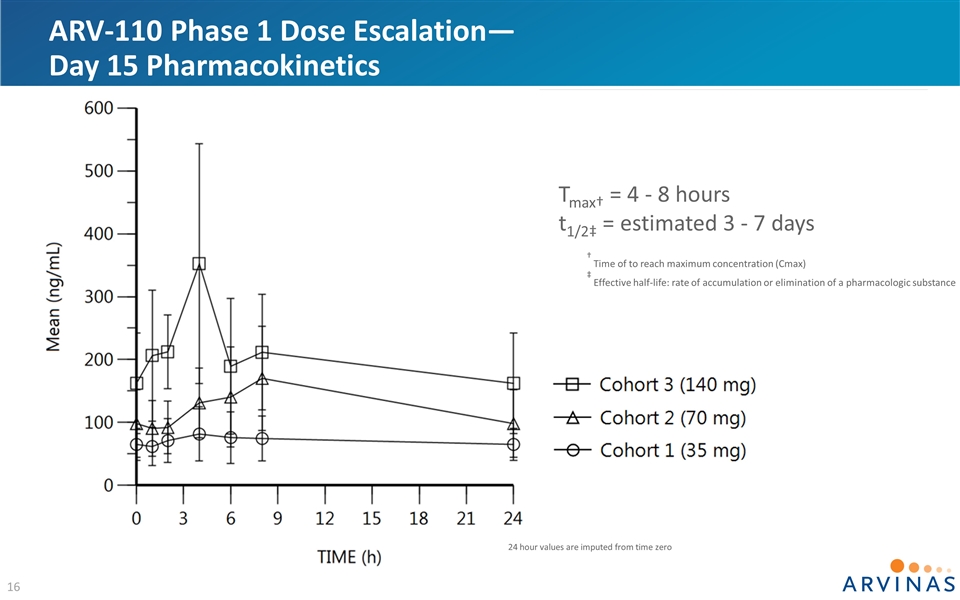
ARV-110 Phase 1 Dose Escalation— Day 15 Pharmacokinetics Tmax† = 4 - 8 hours t1/2‡ = estimated 3 - 7 days † Time of to reach maximum concentration (Cmax) ‡ Effective half-life: rate of accumulation or elimination of a pharmacologic substance 24 hour values are imputed from time zero
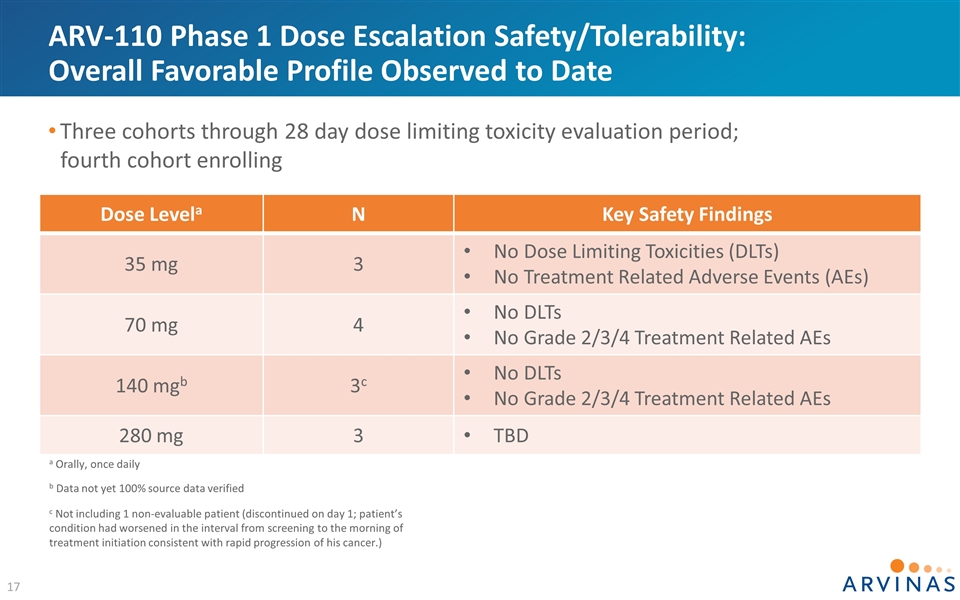
ARV-110 Phase 1 Dose Escalation Safety/Tolerability: Overall Favorable Profile Observed to Date Dose Levela N Key Safety Findings 35 mg 3 No Dose Limiting Toxicities (DLTs) No Treatment Related Adverse Events (AEs) 70 mg 4 No DLTs No Grade 2/3/4 Treatment Related AEs 140 mgb 3c No DLTs No Grade 2/3/4 Treatment Related AEs 280 mg 3 TBD c Not including 1 non-evaluable patient (discontinued on day 1; patient’s condition had worsened in the interval from screening to the morning of treatment initiation consistent with rapid progression of his cancer.) b Data not yet 100% source data verified a Orally, once daily Three cohorts through 28 day dose limiting toxicity evaluation period; fourth cohort enrolling
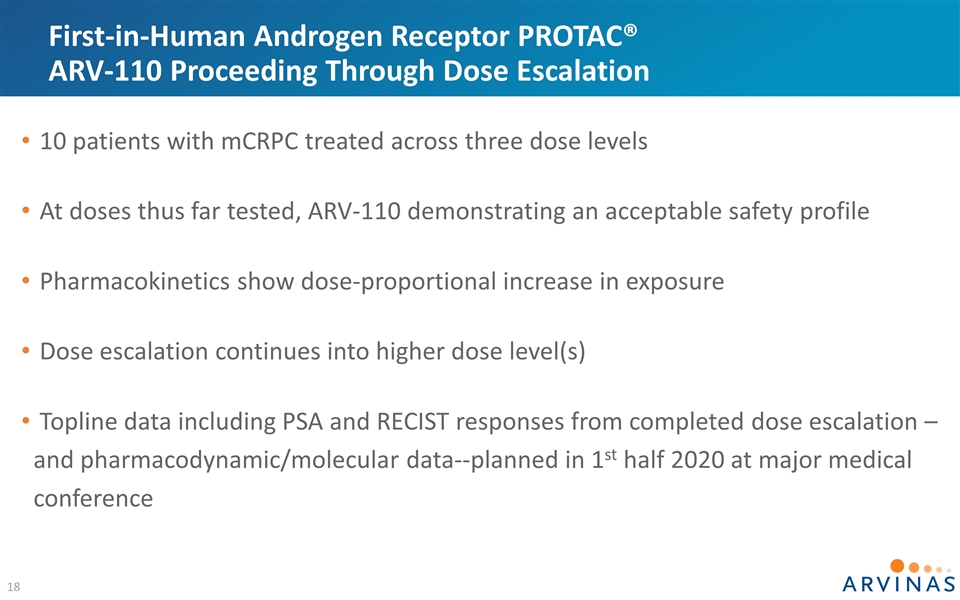
First-in-Human Androgen Receptor PROTAC® ARV-110 Proceeding Through Dose Escalation 10 patients with mCRPC treated across three dose levels At doses thus far tested, ARV-110 demonstrating an acceptable safety profile Pharmacokinetics show dose-proportional increase in exposure Dose escalation continues into higher dose level(s) Topline data including PSA and RECIST responses from completed dose escalation –and pharmacodynamic/molecular data--planned in 1st half 2020 at major medical conference
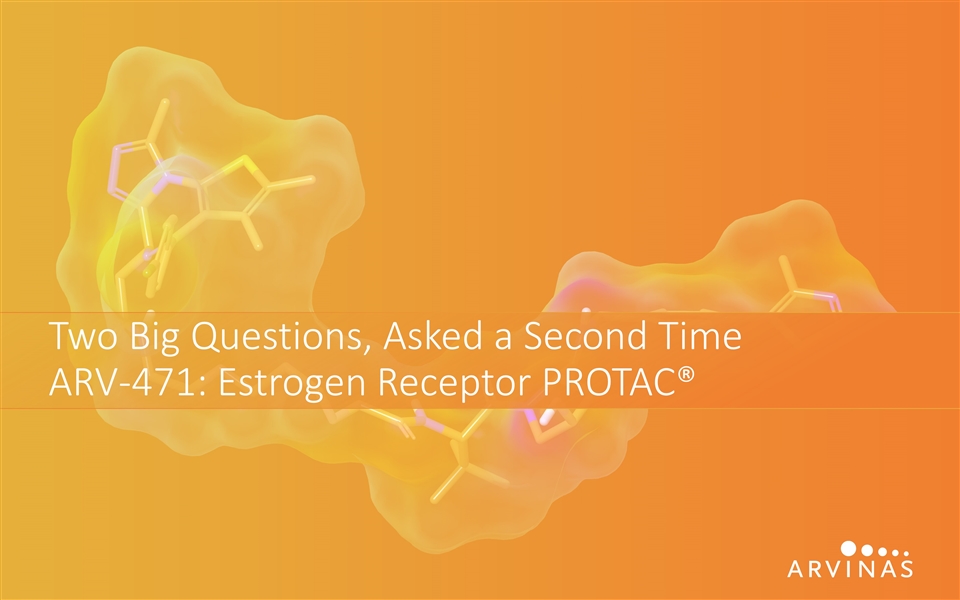
Two Big Questions, Asked a Second Time ARV-471: Estrogen Receptor PROTAC®
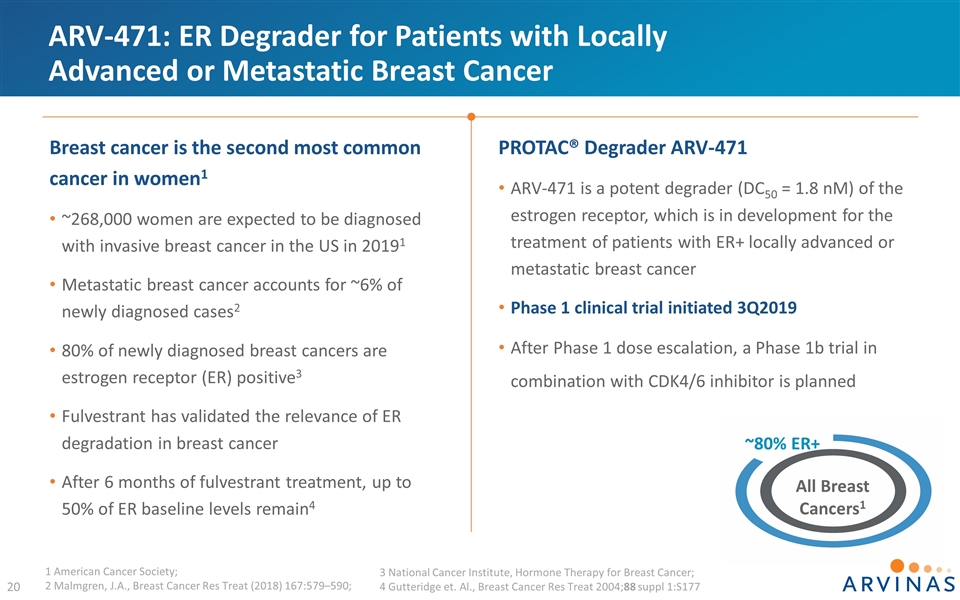
All Breast Cancers1 ~80% ER+ Breast cancer is the second most common cancer in women1 ~268,000 women are expected to be diagnosed with invasive breast cancer in the US in 20191 Metastatic breast cancer accounts for ~6% of newly diagnosed cases2 80% of newly diagnosed breast cancers are estrogen receptor (ER) positive3 Fulvestrant has validated the relevance of ER degradation in breast cancer After 6 months of fulvestrant treatment, up to 50% of ER baseline levels remain4 PROTAC® Degrader ARV-471 ARV-471 is a potent degrader (DC50 = 1.8 nM) of the estrogen receptor, which is in development for the treatment of patients with ER+ locally advanced or metastatic breast cancer Phase 1 clinical trial initiated 3Q2019 After Phase 1 dose escalation, a Phase 1b trial in combination with CDK4/6 inhibitor is planned ARV-471: ER Degrader for Patients with Locally Advanced or Metastatic Breast Cancer 1 American Cancer Society; 2 Malmgren, J.A., Breast Cancer Res Treat (2018) 167:579–590; 3 National Cancer Institute, Hormone Therapy for Breast Cancer; 4 Gutteridge et. Al., Breast Cancer Res Treat 2004;88 suppl 1:S177
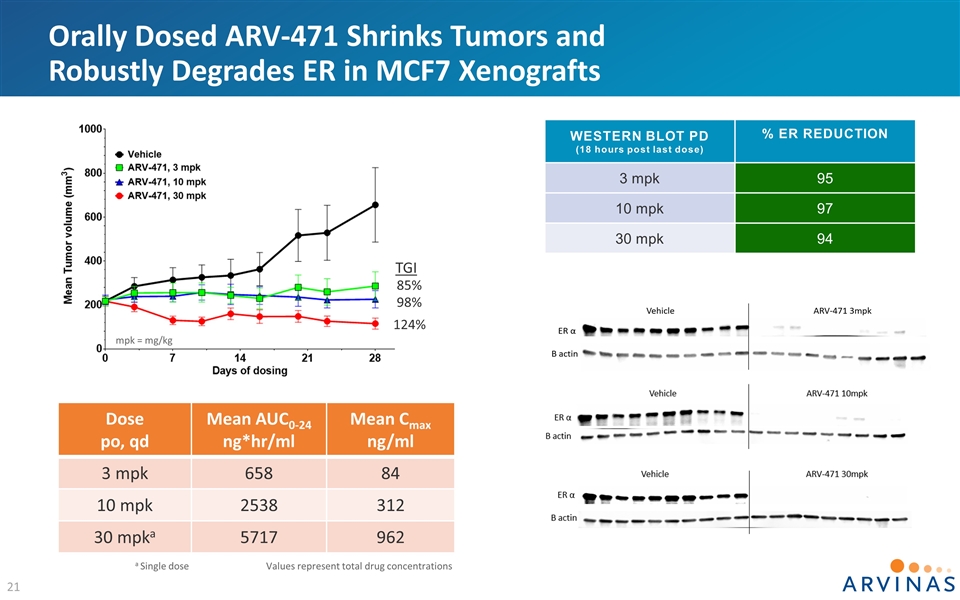
Orally Dosed ARV-471 Shrinks Tumors and Robustly Degrades ER in MCF7 Xenografts WESTERN BLOT PD (18 hours post last dose) % ER REDUCTION 3 mpk 95 10 mpk 97 30 mpk 94 Dose po, qd Mean AUC0-24 ng*hr/ml Mean Cmax ng/ml 3 mpk 658 84 10 mpk 2538 312 30 mpka 5717 962 TGI 85% 98% 124% mpk = mg/kg Values represent total drug concentrations a Single dose
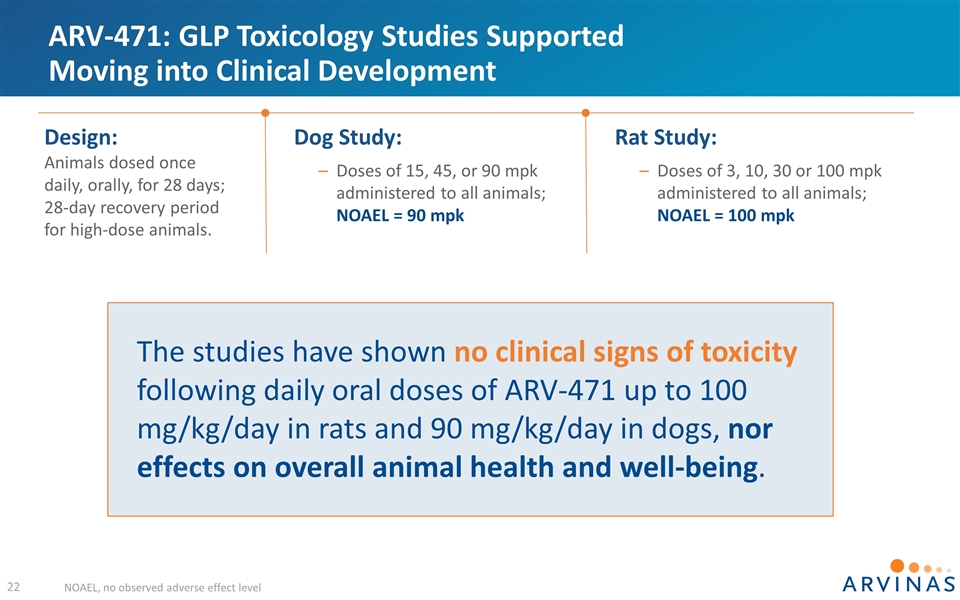
NOAEL, no observed adverse effect level ARV-471: GLP Toxicology Studies Supported Moving into Clinical Development The studies have shown no clinical signs of toxicity following daily oral doses of ARV-471 up to 100 mg/kg/day in rats and 90 mg/kg/day in dogs, nor effects on overall animal health and well-being. Rat Study: Doses of 3, 10, 30 or 100 mpk administered to all animals; NOAEL = 100 mpk Design: Animals dosed once daily, orally, for 28 days; 28-day recovery period for high-dose animals. Dog Study: Doses of 15, 45, or 90 mpk administered to all animals; NOAEL = 90 mpk
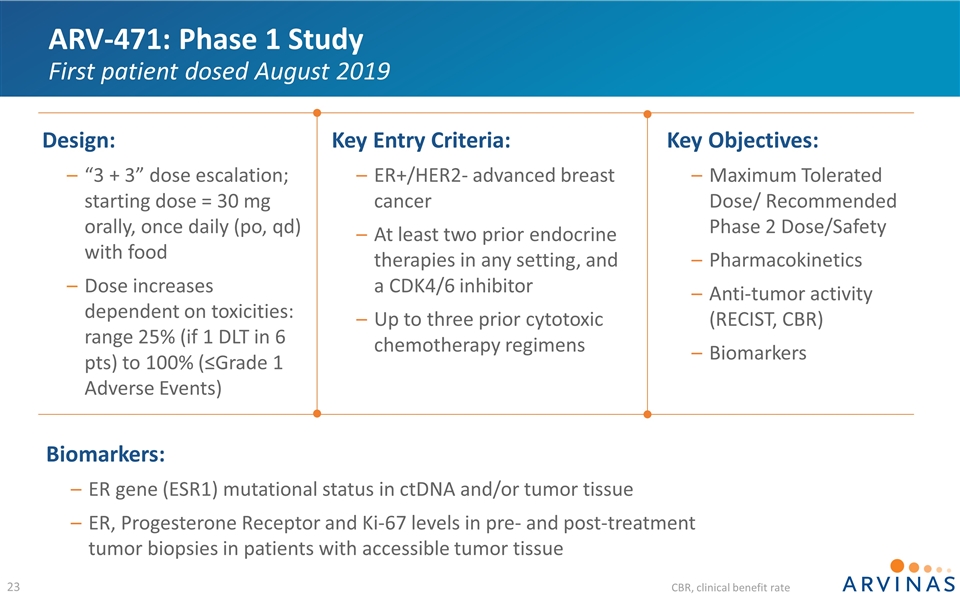
ARV-471: Phase 1 Study First patient dosed August 2019 Biomarkers: Key Objectives: Maximum Tolerated Dose/ Recommended Phase 2 Dose/Safety Pharmacokinetics Anti-tumor activity (RECIST, CBR) Biomarkers Biomarkers: ER gene (ESR1) mutational status in ctDNA and/or tumor tissue ER, Progesterone Receptor and Ki-67 levels in pre- and post-treatment tumor biopsies in patients with accessible tumor tissue Design: “3 + 3” dose escalation; starting dose = 30 mg orally, once daily (po, qd) with food Dose increases dependent on toxicities: range 25% (if 1 DLT in 6 pts) to 100% (≤Grade 1 Adverse Events) Key Entry Criteria: ER+/HER2- advanced breast cancer At least two prior endocrine therapies in any setting, and a CDK4/6 inhibitor Up to three prior cytotoxic chemotherapy regimens CBR, clinical benefit rate
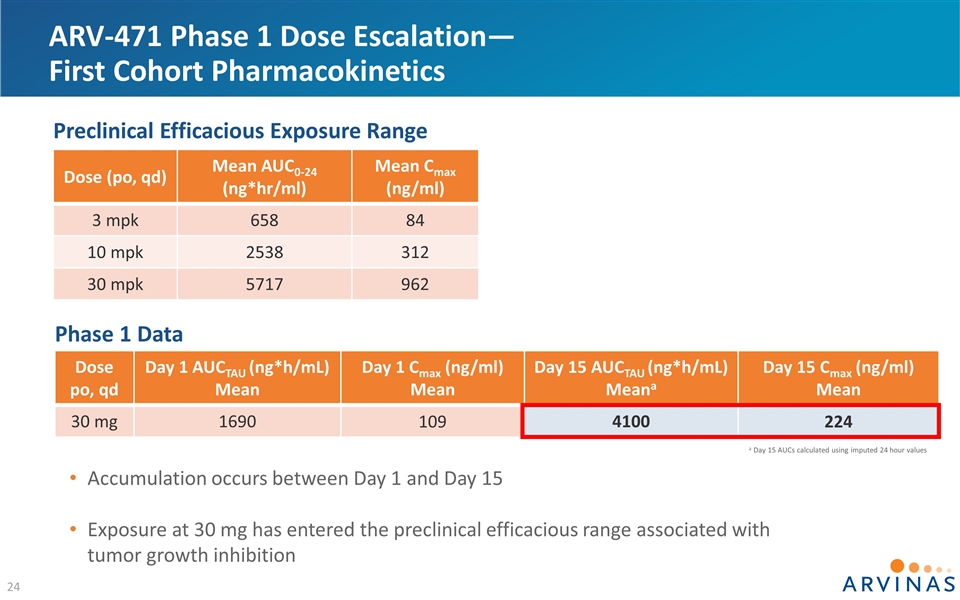
ARV-471 Phase 1 Dose Escalation— First Cohort Pharmacokinetics Dose po, qd Day 1 AUCTAU (ng*h/mL) Mean Day 1 Cmax (ng/ml) Mean Day 15 AUCTAU (ng*h/mL) Meana Day 15 Cmax (ng/ml) Mean 30 mg 1690 109 4100 224 Phase 1 Data Dose (po, qd) Mean AUC0-24 (ng*hr/ml) Mean Cmax (ng/ml) 3 mpk 658 84 10 mpk 2538 312 30 mpk 5717 962 Preclinical Efficacious Exposure Range a Day 15 AUCs calculated using imputed 24 hour values Accumulation occurs between Day 1 and Day 15 Exposure at 30 mg has entered the preclinical efficacious range associated with tumor growth inhibition
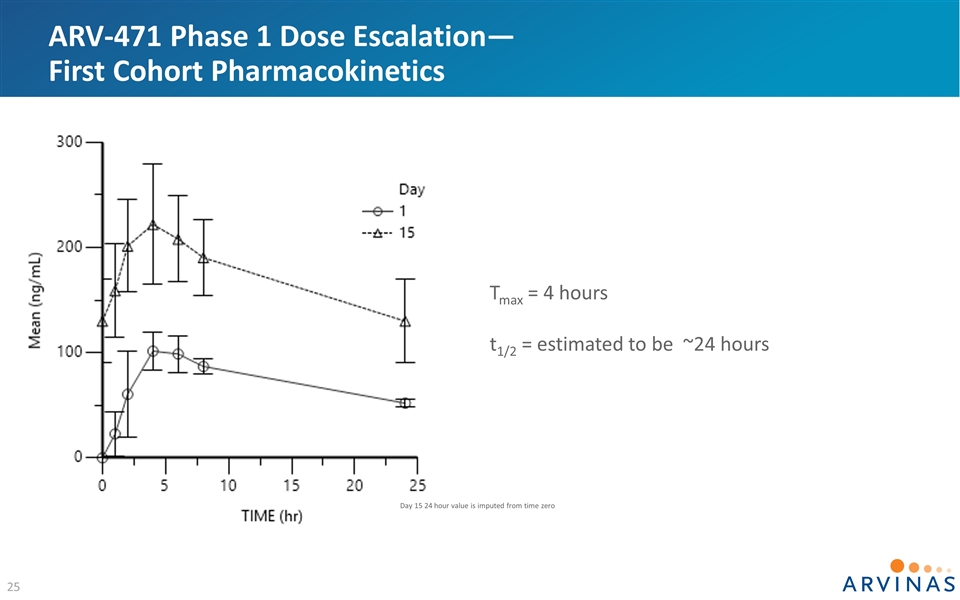
ARV-471 Phase 1 Dose Escalation— First Cohort Pharmacokinetics Tmax = 4 hours t1/2 = estimated to be ~24 hours Day 15 24 hour value is imputed from time zero
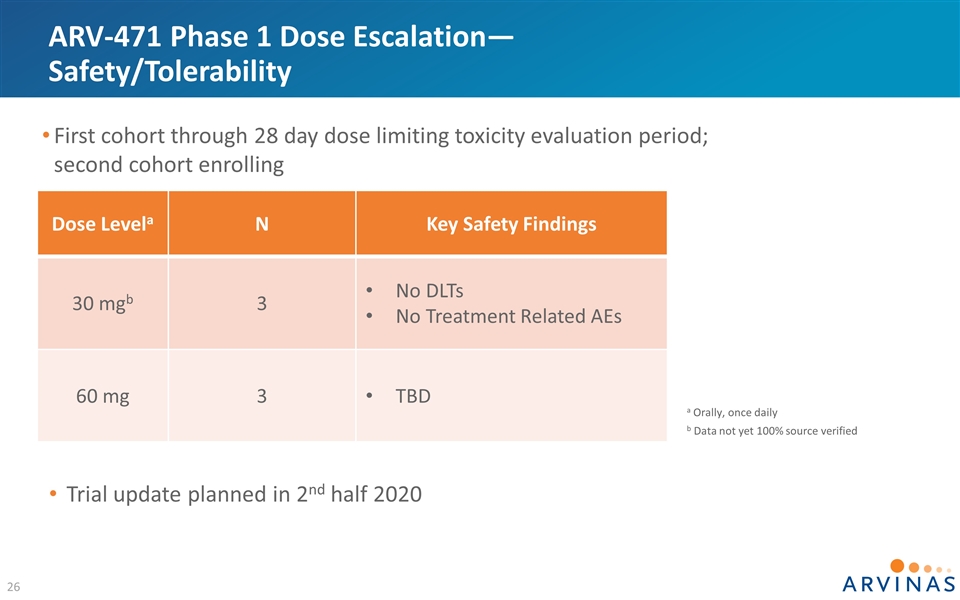
ARV-471 Phase 1 Dose Escalation—Safety/Tolerability Dose Levela N Key Safety Findings 30 mgb 3 No DLTs No Treatment Related AEs 60 mg 3 TBD b Data not yet 100% source verified Trial update planned in 2nd half 2020 a Orally, once daily First cohort through 28 day dose limiting toxicity evaluation period; second cohort enrolling
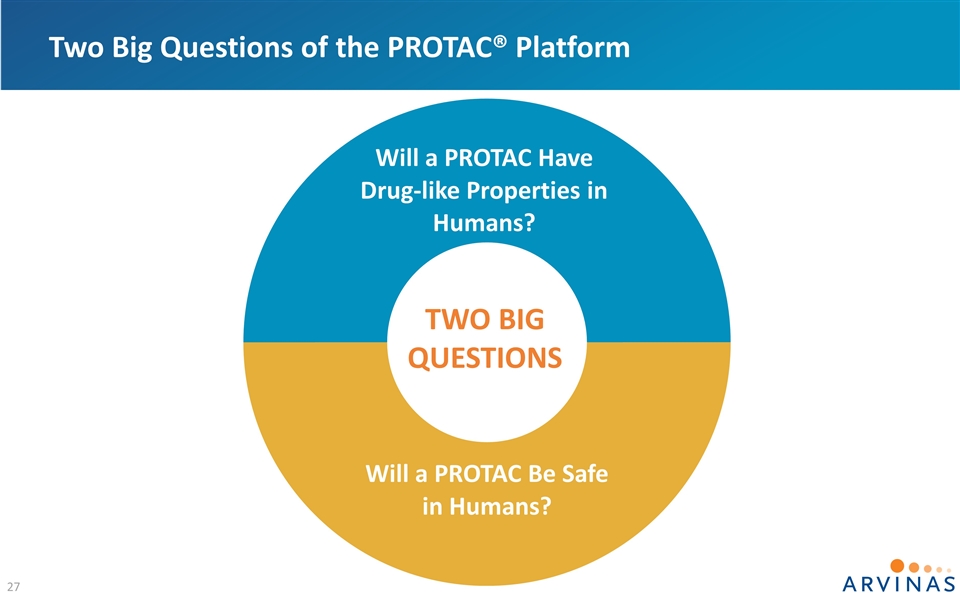
Two Big Questions of the PROTAC® Platform TWO BIG QUESTIONS
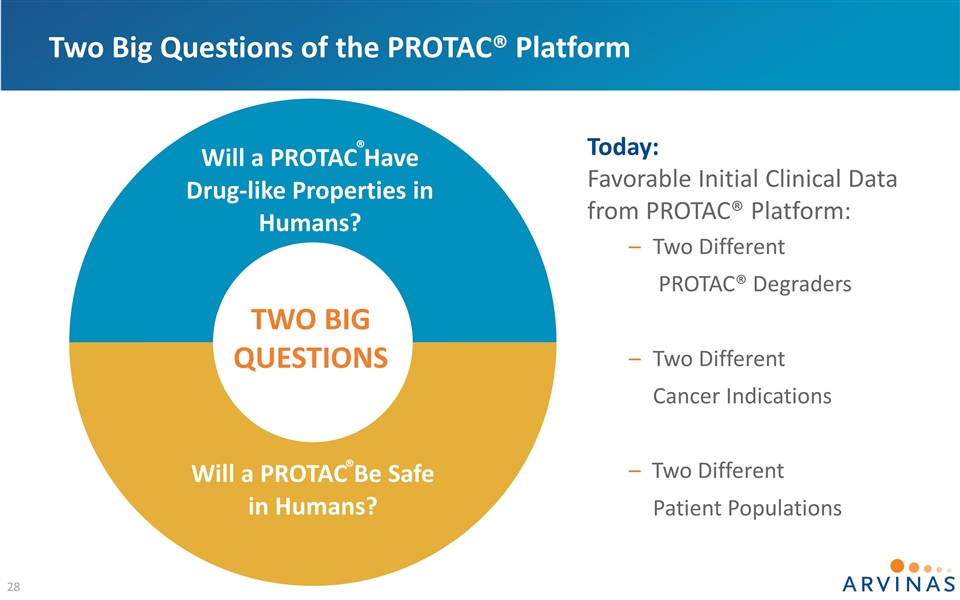
Two Big Questions of the PROTAC® Platform Today: Favorable Initial Clinical Data from PROTAC® Platform: Two Different PROTAC® Degraders Two Different Cancer Indications Two Different Patient Populations TWO BIG QUESTIONS
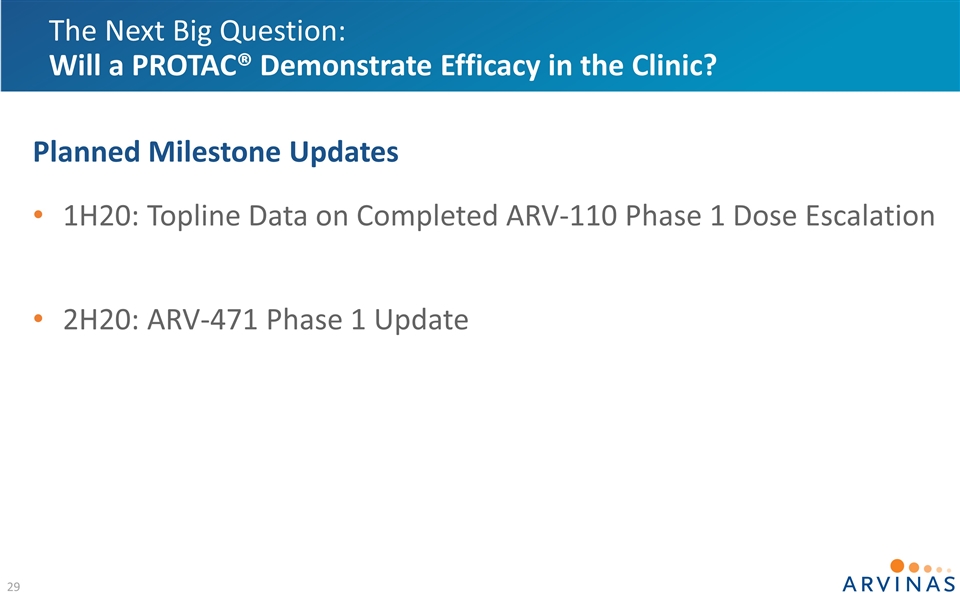
The Next Big Question: Will a PROTAC® Demonstrate Efficacy in the Clinic? Planned Milestone Updates 1H20: Topline Data on Completed ARV-110 Phase 1 Dose Escalation 2H20: ARV-471 Phase 1 Update
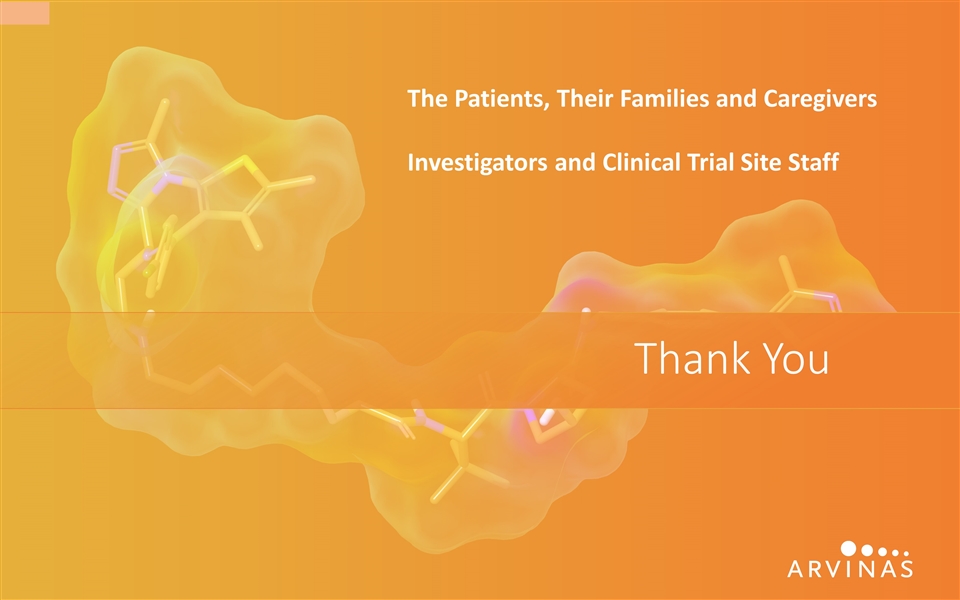
Thank You The Patients, Their Families and Caregivers Investigators and Clinical Trial Site Staff

And All Arvinas Colleagues!






























